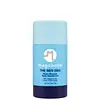megababe The Geo Deo Multi-Mineral Daily Deodorant Versus Lume Whole Body Deodorant Invisible Cream Stick
What's inside
What's inside
 Key Ingredients
Key Ingredients

 Benefits
Benefits

 Concerns
Concerns

 Ingredients Side-by-side
Ingredients Side-by-side

Caprylic/Capric Triglyceride
MaskingTapioca Starch
Stearyl Alcohol
EmollientButyrospermum Parkii Butter
Skin ConditioningSodium Bicarbonate
AbrasiveMagnesium Hydroxide
AbsorbentCocos Nucifera Oil
MaskingTriethyl Citrate
MaskingHydrogenated Castor Oil
EmollientHelianthus Annuus Seed Oil
EmollientBehenyl Alcohol
EmollientPolyglyceryl-3 Stearate
EmulsifyingEucalyptus Globulus Oil
Cedrus Atlantica Bark Oil
MaskingZinc Ricinoleate
Zinc Oxide
Cosmetic ColorantXylityl Sesquicaprylate
AntimicrobialLactobacillus Ferment
Skin ConditioningSilica
AbrasiveKaolin
AbrasiveAvena Sativa Kernel Flour
AbrasiveCichorium Intybus Seed Oil
AntioxidantHippophae Rhamnoides Fruit Oil
Skin ProtectingTocopherol
AntioxidantMagnesium Ascorbyl Phosphate
AntioxidantMentha Piperita Oil
MaskingBenzyl Acetate
MaskingCitronellol
PerfumingHexyl Cinnamal
PerfumingMethyl Salicylate
PerfumingMethyl Benzoate
PerfumingCoumarin
PerfumingHydroxycitronellal
PerfumingCarvone
MaskingLinalool
PerfumingTerpineol
MaskingMaltodextrin
AbsorbentAnhydroxylitol
HumectantCitrus Aurantifolia Oil
CleansingCaprylic/Capric Triglyceride, Tapioca Starch, Stearyl Alcohol, Butyrospermum Parkii Butter, Sodium Bicarbonate, Magnesium Hydroxide, Cocos Nucifera Oil, Triethyl Citrate, Hydrogenated Castor Oil, Helianthus Annuus Seed Oil, Behenyl Alcohol, Polyglyceryl-3 Stearate, Eucalyptus Globulus Oil, Cedrus Atlantica Bark Oil, Zinc Ricinoleate, Zinc Oxide, Xylityl Sesquicaprylate, Lactobacillus Ferment, Silica, Kaolin, Avena Sativa Kernel Flour, Cichorium Intybus Seed Oil, Hippophae Rhamnoides Fruit Oil, Tocopherol, Magnesium Ascorbyl Phosphate, Mentha Piperita Oil, Benzyl Acetate, Citronellol, Hexyl Cinnamal, Methyl Salicylate, Methyl Benzoate, Coumarin, Hydroxycitronellal, Carvone, Linalool, Terpineol, Maltodextrin, Anhydroxylitol, Citrus Aurantifolia Oil
Water
Skin ConditioningMandelic Acid
AntimicrobialMaranta Arundinacea Root Powder
Skin ConditioningTapioca Starch
Isoamyl Laurate
EmollientHydroxypropyl Starch Phosphate
Cetearyl Alcohol
EmollientCaffeine
Skin ConditioningCaprylic/Capric Triglyceride
MaskingBehenyl Alcohol
EmollientHydrogenated Castor Oil
EmollientAloe Barbadensis Leaf Juice
Skin ConditioningTheobroma Cacao Seed Butter
EmollientTocopherol
AntioxidantAllantoin
Skin ConditioningPanthenol
Skin ConditioningSandalore
Stearyl Alcohol
EmollientDimethicone
EmollientCetearyl Glucoside
EmulsifyingPentylene Glycol
Skin ConditioningPhenylpropanol
MaskingPotassium Hydroxide
BufferingDipropylene Glycol
HumectantSodium Benzoate
MaskingTetrasodium Glutamate Diacetate
Water, Mandelic Acid, Maranta Arundinacea Root Powder, Tapioca Starch, Isoamyl Laurate, Hydroxypropyl Starch Phosphate, Cetearyl Alcohol, Caffeine, Caprylic/Capric Triglyceride, Behenyl Alcohol, Hydrogenated Castor Oil, Aloe Barbadensis Leaf Juice, Theobroma Cacao Seed Butter, Tocopherol, Allantoin, Panthenol, Sandalore, Stearyl Alcohol, Dimethicone, Cetearyl Glucoside, Pentylene Glycol, Phenylpropanol, Potassium Hydroxide, Dipropylene Glycol, Sodium Benzoate, Tetrasodium Glutamate Diacetate
 Reviews
Reviews

Ingredients Explained
These ingredients are found in both products.
Ingredients higher up in an ingredient list are typically present in a larger amount.
Behenyl Alcohol is a type of fatty alcohol (these are different from the drying, solvent alcohols).
Fatty Alcohols have hydrating properties and are most often used as an emollient or to thicken a product. They are usually derived from natural fats and oils; behenyl alcohol is derived from the fats of vegetable oils.
Emollients help keep your skin soft and hydrated by creating a film that traps moisture in.
In 2000, Behenyl Alcohol was approved by the US as medicine to reduce the duration of cold sores.
Learn more about Behenyl AlcoholThis ingredient is an emollient, solvent, and texture enhancer. It is considered a skin-softener by helping the skin prevent moisture loss.
It helps thicken a product's formula and makes it easier to spread by dissolving clumping compounds.
Caprylic Triglyceride is made by combining glycerin with coconut oil, forming a clear liquid.
While there is an assumption Caprylic Triglyceride can clog pores due to it being derived from coconut oil, there is no research supporting this.
Learn more about Caprylic/Capric TriglycerideHydrogenated Castor Oil is created by adding hydrogen to castor oil. This helps stabilize the castor oil and raises the melting point. At room temperature, hydrogenated castor oil is solid.
Castor Oil helps moisturize the skin. It is rich in a fatty acid called ricinoleic acid. This fatty acid helps prevent moisture loss on the skin. This helps keep your skin soft and hydrated. Ricinoleic acid also has anti-inflammatory and pain reducing properties.
As a wax-like substance, Hydrogenated Castor Oil acts as an emollient. Emollients help keep your skin stay soft and smooth by creating a barrier. This barrier helps trap moisture.
Hydrogenated Castor Oil may not be fungal-acne safe. We recommend speaking with a professional.
Learn more about Hydrogenated Castor OilStearyl Alcohol is a type of fatty alcohol from stearic acid. It is a white, waxy compound used to emulsify ingredients.
Fatty Alcohols are most often used as an emollient or to thicken a product. Emollients help soothe and hydrate the skin by trapping moisture.
They are usually derived from natural fats and oils and therefore do not have the same drying or irritating effect as solvent alcohols. FDA allows products labeled "alcohol-free" to have fatty alcohols.
Learn more about Stearyl AlcoholTapioca starch is a thickening agent and is made from the cassava root, also known as yucca.
According to a manufacturer, it is an excellent talc replacement.
It is gluten-free.
Learn more about Tapioca StarchTocopherol (also known as Vitamin E) is a common antioxidant used to help protect the skin from free-radicals and strengthen the skin barrier. It's also fat soluble - this means our skin is great at absorbing it.
Vitamin E also helps keep your natural skin lipids healthy. Your lipid skin barrier naturally consists of lipids, ceramides, and fatty acids. Vitamin E offers extra protection for your skin’s lipid barrier, keeping your skin healthy and nourished.
Another benefit is a bit of UV protection. Vitamin E helps reduce the damage caused by UVB rays. (It should not replace your sunscreen). Combining it with Vitamin C can decrease sunburned cells and hyperpigmentation after UV exposure.
You might have noticed Vitamin E + C often paired together. This is because it is great at stabilizing Vitamin C. Using the two together helps increase the effectiveness of both ingredients.
There are often claims that Vitamin E can reduce/prevent scarring, but these claims haven't been confirmed by scientific research.
Learn more about Tocopherol